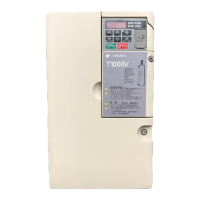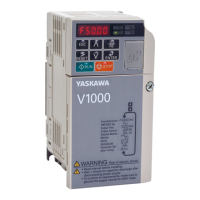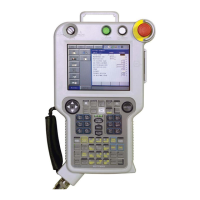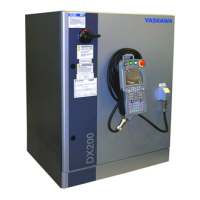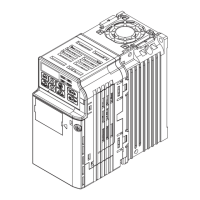5.11 S: Functions for Textile Applications
YASKAWA ELECTRIC SIEP C710616 30B YASKAWA AC Drive T1000A Technical Manual 253
Parameter Details
5
• AC Input supply is lost, and is detected by hardware detection circuit (enabled as default by S4-15).
• The 1 phase loss of the power supply is detected by measuring the ripple of the DC bus voltage. The detection is tuned
with parameters S4-08 (KEB 1 phase loss detection level), S4-09 (KEB 1 phase loss sampling time) and S4-10 (KEB 1
Phase Loss Detection Intervals), see Figure 5.92 for details.
The DC bus ripple is defined as: VDC max - VDC min. It is measured within the time period of S4-09 with a scan time
between 100 and 250 μsec, depending on the carrier frequency.
When the measured DC bus ripple is bigger than the value set in S4-08 for the time S4-09 × S4-10, phase loss is
detected and the KEB function is started.
Figure 5.92
Figure 5.92 One Phase Loss Detection
Conditions that Stop KEB
While KEB is being executed, any one of the following conditions will stop the KEB process.
• All the conditions that trigger KEB are no longer present, the minimum time for KEB (S4-13) has passed, and the DC
bus voltage is greater than the level required for KEB to complete (S4-06) for longer than the time set in S4-07.
Note: KEB cannot complete until the time set to S4-07 has passed, even if all other conditions to stop KEB have been met.
• Once power is restored, the input terminal set for KEB (H1- = 65 or 66) that triggered KEB is released.
Note: When an input terminal is programmed to trigger KEB, the operation of KEB depends on the opening and closing of that
terminal. Other conditions are not relevant in this case.
• KEB 2 is being used and deceleration took longer than L2-02. In this case, KEB 2 will be stopped and the drive will
trip with a UV1 fault.
Note: When triggering KEB by dV/dt detection only, be sure that S4-03 and S4-13 are accurately set. Otherwise, KEB operation might
end before the supply power has been restored. Set S4-11 < S4-03 < 1.35 × E1-01.
DC Bus Voltage Control (KEB 1), Power KEB (KEB 3)
Below Figure 5.93 demonstrates how KEB 1 and KEB 3 operate.
The KEB function is triggered when one of the previously explained conditions becomes true. The KEB function starts
by immediately applying a frequency gain in order to bring the motor into a regenerative state, then quickly decelerates
the motor.
The deceleration is performed for at least the time set in parameter S4-13. The drive controls the deceleration so that the
energy needed to keep the DC bus voltage at the level set in S4-11 is fed from the rotating system back into the drive.
KEB 1 (S4-01 = 1) uses the deceleration times set in S5-01 and S5-02 as a base, and adjusts the deceleration rate
depending on the DC bus voltage. KEB 3 (S4-01 = 3) uses motor and machine inertia data only to calculate the optimal
deceleration rate. The deceleration time settings have no effect during KEB 3.
The KEB function ends as described above. If KEB has not been triggered by single phase loss detection and the output
frequency is greater than S4-14, the drive will hold the output frequency for the time set in parameter S4-12, then
accelerate back to the frequency reference. The acceleration time is defined by parameter S5-05. If S5-05 is set to 0, then
the drive uses the acceleration times set in C1-01, C1-03, C1-05, and C1-07.
Note: 1. Make sure that the Run command remains enabled during power loss. If the Run command is released, then the drive will not be able
to accelerate back up to the frequency reference once power is restored. Removing the Run command during Power KEB will bring
the drive ramping down to zero with standard ramp time.
2. When Power KEB has been started by digital input H1- = 65/66, and the power loss detection relay has failed (input stays on)
while S4-11 is set below 1.35, the drive will reaccelerate without waiting for the time set in S4-12. The ramp time will not be S5-05
or the standard ramp, but will be calculated by the drive.
ACR
period
S4-09S4-09
VDC max
VDC min
DC bus
ripple
YEG

